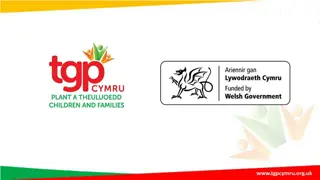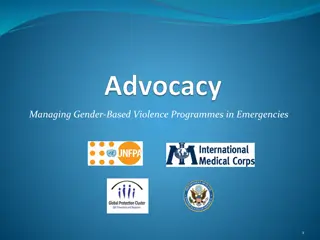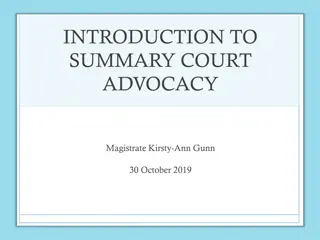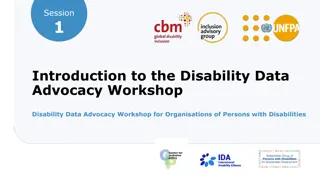ADAPT Activism: Empowering Disability Rights Advocates
ADAPT, a national grassroots community, engages in nonviolent direct action to ensure the civil and human rights of people with disabilities. This movement, led by individuals like Stephanie Woodward, plays a crucial role in shaping policies and advocating for accessibility and equality. Through systems advocacy, ADAPT works hand in hand with Centers for Independent Living (CILs) to bring about meaningful change and address key issues faced by the disability community.
Download Presentation

Please find below an Image/Link to download the presentation.
The content on the website is provided AS IS for your information and personal use only. It may not be sold, licensed, or shared on other websites without obtaining consent from the author.If you encounter any issues during the download, it is possible that the publisher has removed the file from their server.
You are allowed to download the files provided on this website for personal or commercial use, subject to the condition that they are used lawfully. All files are the property of their respective owners.
The content on the website is provided AS IS for your information and personal use only. It may not be sold, licensed, or shared on other websites without obtaining consent from the author.
E N D
Presentation Transcript
Advocacy ADAPT Style: Organizing ADAPT Activism Through CILs
What is ADAPT? National grass-roots community Disability rights activists engaging in nonviolent direct action, including civil disobedience Working to to assure the civil & human rights of people with disabilities to live in freedom.
What is ADAPT? Driving force behind the ADA The reason we have lifts on busses Bulldogs of the Disability Rights Movement Creator of the Disability Integration Act!
Tell me more about ADAPT Where: Nation wide! Who: Disabled and nondisabled activists who believe in disability rights.
Who am I to ADAPT? Stephanie Woodward Rochester ADAPT 6 arrests & counting Lawyer for national positions Organizer Chanter Color Leader CFC Co-chair Arrestee
Who am I to my CIL? Stephanie Woodward Director of Advocacy at the Center for Disability Rights Lawyer for local issues Policy writer/negotiator
How did I get involved with ADAPT? Interned at CDR, went on a state action as an intern at my CIL and got hooked. CIL is very supportive of ADAPT
How Does ADAPT relate to your CIL? Systems Advocacy is a core service! What is it? Can we do it? Why would we do it? How do we do it? What are we going to do?
Systems Advocacy is a Core Service! It s fun to do! It s required of all Centers! You get paid to make the world a better place! Results are literally life changing! Not the same as lobbying. Works hand in hand with individual services.
Why do Systems Advocacy with ADAPT? Have you ever had a problem Securing accessible, affordable, integrated housing? Securing needed attendant services? Getting and keeping a job? Getting into or through public venues, stores, government offices, etc.? Finding accessible parking? Communicating with doctors or in court systems due to lack of interpreters?
Why do Systems Advocacy with ADAPT? What can you do about these struggles? Accept inaccessibility and discrimination. Conform to the demands of the nondisabled majority. OR Mobilize a community wide effort to remove barriers. Pick priorities and fight for them. Educate the community about disabled people and disability rights.
Why do Systems Advocacy with ADAPT? If you re not here to make the world a better place then why are you here? Our people have been oppressed & don t know their rights or how to exert them. We can teach & empower our people by including them in our advocacy efforts. Our people are still oppressed & trapped in institutions. They can t fight for their freedom, so we must.
Why do Systems Advocacy with ADAPT? We are the experts on what we want & need If we don t speak for ourselves, others will speak for us. The usual culprits are: Parents Doctors Unions Staff, social workers Service Provider Associations
Why do Systems Advocacy with ADAPT? Advocacy is not just for radicals, or loud people, or other people. Advocacy is for everyone! Anyone can be an advocate and it is crucial to identify each person s skills and utilize them. Systems Advocacy & Direct Services are interdependent Direct services identify the barriers Systems Advocacy removes the barriers
ADAPTs Pitchfork of Systems Advocacy In no particular order Media Legal Legislative Administrative Direct Action The most effective advocates use multiple prongs
ADAPTs Pitchfork: MEDIA What is it? Using the media to educate the public, influence policy, and explain how public policies affect lives of people with disabilities. Best practices: Calling out businesses or entities that discriminate against people with disabilities and using the force of public opinion to make them change their behavior. Sending out press releases when good or bad things happen to educate your community about your issues!
ADAPTs Pitchfork: MEDIA examples City refused to clear sidewalks of snow. News outlets covered us talking about the issue, the law, and took video of us trying to get through the snow. Then radio stations talked about it the next day! TV, Radio, and print news covered our ADA events which helped us get more people to events, and also educate our community about the ADA. Sending out press releases before a direct action can get media there sooner, and put a lot of heat on the opposition once they re in the public eye!
ADAPTs Pitchfork: LEGAL What is it? Use existing anti-discrimination laws to challenge discriminatory practices. Best practices: Sending letters to businesses informing them of the ADA, their violations, and how they can fix it. This can lead them to fix the issues without a lawsuit. - Filing DOJ complaints or state human rights law complaints. - Suing businesses or entities that refuse to comply with the ADA. -
ADAPTs Pitchfork: LEGAL examples Examples: - Letters to local businesses resulted in building ramps, installing doorbells, and removing steps without lawsuits. - Letters also resulted in businesses staunchly refusing to comply with the ADA, and lead to successful lawsuits. - DOT complaints lead to an investigation of our local transportation company.
ADAPTs Pitchfork: LEGISLATIVE What is it? Influencing elected officials and their staff in order to affect public policy through phone calls, visits, emails, and social media.* Best Practices: - Call-in days encouraging legislators to support disability rights - Office visits with legislator s constituents to tell personal stories *Advocacy and lobbying are not the same thing. Lobbying involves stating or influencing others to state an opinion on specific legislation. Nonprofits are allowed to do a certain amount of lobbying, but NOT with federal funds. Legislative advocacy can and should be a major aspect of your advocacy. See https://www.independentsector.org/lobbying_guidelines_public_charities
ADAPTs Pitchfork: LEGISLATIVE Examples: - Using social media (Twitter & Facebook) to encourage Senator Schumer to introduce legislation that would enforce the right of disabled people to live in the community. - Bringing constituents to their legislator s office to discuss why affordable, accessible, integrated housing is needed. - Encouraging advocates to email their legislators to describe how lever voting machines prevent them from participating in the voting process.
ADAPTs Pitchfork: ADMINISTRATIVE What is it? Influencing state agencies, businesses, organizations, administrations, and other entities. Best Practices: Submitting comments on proposed laws as to how it will affect people with disabilities Testifying at hearings for proposed changes to policies affecting disabled people Developing strong leaders with disabilities and helping them get appointed to the agencies/businesses in order to have the disability perspective on the inside. - - -
ADAPTs Pitchfork: ADMINISTRATIVE Examples: Testifying when transportation company considered cutting routes which would then cut disabled people off from paratransit. Submitting written comments when the NYS Building Codes were going to be amended to decrease required accessibility. Training people with disabilities from our Leadership Academy and helping them get into positions of power in other organizations.
ADAPTs Pitchfork: DIRECT ACTION What is it? Non-violent direct action, such as civil disobedience, street theater, and rallies can be used to bring about systems change. Best Practices: - Street theater outside of an inaccessible restaurant - Holding signs & chanting outside of a discriminatory entity - Rally outside of a government office that is violating/not enforcing disability rights.
ADAPTs Pitchfork: DIRECT ACTION Examples: - Interrupting Clinton Rally for Disability Integration Act. - Holding signs, chanting, passing out flyers, and blocking the entrances of a new Goodwill store to educate about their subminimum wage practices. - Taking over the Governor s rotunda and singing a disability version of 12 Days of Christmas to secure funding for attendant services. - Let them hear footsteps.
Using ADAPTs Pitchfork Each fork can be used individually or together Great for creating Good Cop, Bad Cop situations to push disability rights The Pitchfork can be just as effective with community building as it can be with more assertive, targeted advocacy.
How are ADAPT Chapters organized? Requirements to be a chapter: Be a group Have a local action Attend a national action Organized by individuals or through/by CILs.
Benefits to organizing through a CIL Having a space & a schedule makes organizing easier. Timing matters! Being able to coordinate CIL efforts with ADAPT efforts locally, statewide, and nationally. Number of Activists Funding never hurts!
Balancing CIL and ADAPT issues Keep the orgs separate ADAPT can work out of your CIL without being your CIL. Ex: Your CIL can be politically polite and ADAPT can be the bulldog enforcers. Legal issues: Lobbying Direct Actions Administrative Leave Policies
How Young People can LEAD in ADAPT Workgroups Actions Advocacy Projects (https://www.youtube.com/watch?v=PLPAzs0A5-Q) Lead the charge into a building or lead the media coverage or lead the legal advocacy there s plenty of room to lead in ADAPT!
How we benefit from ADAPT Disability Pride Media interaction Leadership skills Organization skills Public speaking Opportunities to do things most people NEVER get to do: Writing legal briefs for the Supreme Court Negotiating with governors Dinners with Senators, Whitehouse invitations, and more.
How does ADAPT benefit from us? Leveraging our skills Education Social Media Diverse backgrounds New ideas Energy & excitement
How does the MOVEMENT benefit from us? More people to do the work = more work getting done! Spreading messages faster through social media Using our local work to have national benefits
How does the MOVEMENT benefit from us? Bringing intersectionality to disability rights activism Continuing Disability Activism we are the future of the movement!
How does ADAPT & the Movement benefit from us? Disability Integration Act! We wrote DIA We secured cosponsors We secured Clinton & Sanders support We created the social media buzz #DIAToday Memes Logo























